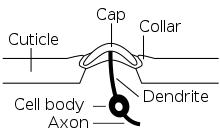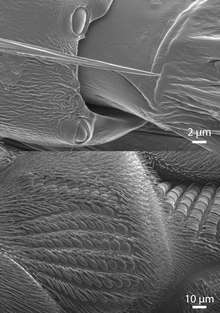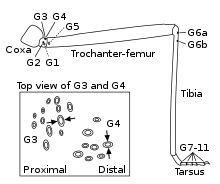Campaniform sensilla
Campaniform sensilla are a class of mechanoreceptors found in insects, which respond to stress and strain within the animal's cuticle. Campaniform sensilla function as proprioceptors that detect mechanical load as resistance to muscle contraction[1][2], similar to mammalian Golgi tendon organs[3][4]. Sensory feedback from campaniform sensilla is integrated in the control of posture and locomotion.[5][6]


Structure
Each campaniform sensillum consists of a flexible dome, which is embedded in a socket within the cuticle and innervated by the dendrites of a single bipolar sensory neuron (see schematic cross-section). Campaniform sensilla are often oval-shaped with long axes of about 5-10 µm (see SEM).

Campaniform sensilla are distributed across the body surface of many insects. Sensilla with similar orientations are often grouped together in regions where stress is likely to be high, including on the legs, antennae, and wings. For example, stick insects have groups of campaniform sensilla on the trochanter, a group on the proximal femur, a group on the proximal tibia, and a small number of sensilla on the distal end of each tarsomere (see leg schematic). In Diptera like blow flies, the highest density of campaniform sensilla is found at the base of the modified hind-wings, or halteres, which function as gyroscopic sensors of self-motion during flight.[7]
Function
The activity of campaniform sensilla was first recorded by John William Sutton Pringle in the late 1930s,[8] who also determined that the oval shape of many sensilla makes them directionally selective.[9] When cuticular deformations compress a campaniform sensillum along its short axis, the socket edges (collar) indent the cuticular cap.[10] This squeezes the dendritic tip of the sensory neuron and opens its mechanotransduction channels, which leads to the firing of action potentials that are transmitted to the central nervous system. Campaniform sensilla signal the magnitude and the rate of cuticular deformation.[1]
In walking control, sensory feedback from leg campaniform sensilla is thought to reinforce muscle activity during the stance phase[1][11][12] and to contribute to inter-leg coordination[13][14], much like sensory feedback from mammalian Golgi tendon organs[15][16].
In flight control, sensory feedback from haltere and wing campaniform sensilla is thought to mediate compensatory reflexes to maintain equilibrium.[17][18]
References
- Zill, Sasha N.; Schmitz, Josef; Chaudhry, Sumaiya; Büschges, Ansgar (2012). "Force encoding in stick insect legs delineates a reference frame for motor control". Journal of Neurophysiology. 108 (5): 1453–1472. doi:10.1152/jn.00274.2012. ISSN 0022-3077. PMC 3774582. PMID 22673329.
- Zill, Sasha N.; Chaudhry, Sumaiya; Büschges, Ansgar; Schmitz, Josef (2013). "Directional specificity and encoding of muscle forces and loads by stick insect tibial campaniform sensilla, including receptors with round cuticular caps". Arthropod Structure & Development. 42 (6): 455–467. doi:10.1016/j.asd.2013.10.001. PMID 24126203.
- Duysens, J.; Clarac, F.; Cruse, H. (2000). "Load-Regulating Mechanisms in Gait and Posture: Comparative Aspects". Physiological Reviews. 80 (1): 83–133. doi:10.1152/physrev.2000.80.1.83. ISSN 0031-9333. PMID 10617766.
- Azim, Eiman; Tuthill, John C. (2018). "Proprioception". Current Biology. 28 (5): R194–R203. doi:10.1016/j.cub.2018.01.064. ISSN 0960-9822. PMID 29510103.
- Zill, Sasha; Schmitz, Josef; Büschges, Ansgar (2004). "Load sensing and control of posture and locomotion". Arthropod Structure & Development. 33 (3): 273–286. doi:10.1016/j.asd.2004.05.005. PMID 18089039.
- Tuthill, John C.; Wilson, Rachel I. (2016). "Mechanosensation and Adaptive Motor Control in Insects". Current Biology. 26 (20): R1022–R1038. doi:10.1016/j.cub.2016.06.070. PMC 5120761. PMID 27780045.
- Pringle, J. W. S. (1948). "The Gyroscopic Mechanism of the Halteres of Diptera". Philosophical Transactions of the Royal Society of London. Series B, Biological Sciences. 233 (602): 347–384. Bibcode:1948RSPTB.233..347P. doi:10.1098/rstb.1948.0007.
- Pringle, John William Sutton (1938). "Proprioception in insects I. A new type of mechanical receptor from the palps of the cockroach". Journal of Experimental Biology. 15 (1): 101–113.
- Pringle, John William Sutton (1938). "Proprioception in insects II. The action of the campaniform sensilla on the legs". Journal of Experimental Biology. 15 (1): 114–131.
- Spinola, S. M.; Chapman, K. M. (1975-09-01). "Proprioceptive indentation of the campaniform sensilla of cockroach legs". Journal of Comparative Physiology. 96 (3): 257–272. doi:10.1007/BF00612698. ISSN 1432-1351.
- Pearson, K. G. (1972). "Central Programming and Reflex Control of Walking in the Cockroach". Journal of Experimental Biology. 56 (1): 173–193. ISSN 0022-0949.
- Zill, Sasha N.; Chaudhry, Sumaiya; Büschges, Ansgar; Schmitz, Josef (2015). "Force feedback reinforces muscle synergies in insect legs". Arthropod Structure & Development. 44 (6): 541–553. doi:10.1016/j.asd.2015.07.001. PMID 26193626.
- Zill, Sasha N.; Keller, Bridget R.; Duke, Elizabeth R. (2009). "Sensory Signals of Unloading in One Leg Follow Stance Onset in Another Leg: Transfer of Load and Emergent Coordination in Cockroach Walking". Journal of Neurophysiology. 101 (5): 2297–2304. doi:10.1152/jn.00056.2009. ISSN 0022-3077. PMID 19261716. S2CID 14691776.
- Dallmann, Chris J.; Hoinville, Thierry; Dürr, Volker; Schmitz, Josef (2017). "A load-based mechanism for inter-leg coordination in insects". Proceedings of the Royal Society B: Biological Sciences. 284 (1868): 20171755. doi:10.1098/rspb.2017.1755. PMC 5740276. PMID 29187626.
- Pearson, K. G. (2008-01-01). "Role of sensory feedback in the control of stance duration in walking cats". Brain Research Reviews. Networks in Motion. 57 (1): 222–227. doi:10.1016/j.brainresrev.2007.06.014. ISSN 0165-0173. PMID 17761295.
- Ekeberg, Örjan; Pearson, Keir (2005-12-01). "Computer Simulation of Stepping in the Hind Legs of the Cat: An Examination of Mechanisms Regulating the Stance-to-Swing Transition". Journal of Neurophysiology. 94 (6): 4256–4268. doi:10.1152/jn.00065.2005. ISSN 0022-3077. PMID 16049149. S2CID 7185159.
- Dickinson, Michael H. (1999). Leeuwen, J. L. van (ed.). "Haltere–mediated equilibrium reflexes of the fruit fly, Drosophila melanogaster". Philosophical Transactions of the Royal Society of London. Series B: Biological Sciences. 354 (1385): 903–916. doi:10.1098/rstb.1999.0442. PMC 1692594. PMID 10382224.
- Fayyazuddin, Amir; Dickinson, Michael H. (1999-10-01). "Convergent Mechanosensory Input Structures the Firing Phase of a Steering Motor Neuron in the Blowfly, Calliphora". Journal of Neurophysiology. 82 (4): 1916–1926. doi:10.1152/jn.1999.82.4.1916. ISSN 0022-3077. PMID 10515981. S2CID 15194097.